Hiring the right network engineer can be a game-changer for your organization, but finding one with the appropriate skills and experience requires asking the right questions. This post aims to provide Cisco Networking interview questions designed to help you identify top candidates effectively.
This blog post will cover different categories of Cisco Networking interview questions, ranging from common inquiries to those focused on protocols, configurations, troubleshooting, and diagnostics. You'll find questions tailored for junior, mid-tier, and senior network engineers to help you gauge their expertise accurately.
Using these questions will streamline your hiring process and ensure you're bringing on capable talent who can handle your network requirements. For a well-rounded evaluation, consider using our Cisco Routing and Switching online test before the interview.
Table of contents
10 common Cisco Networking interview questions to ask your applicants
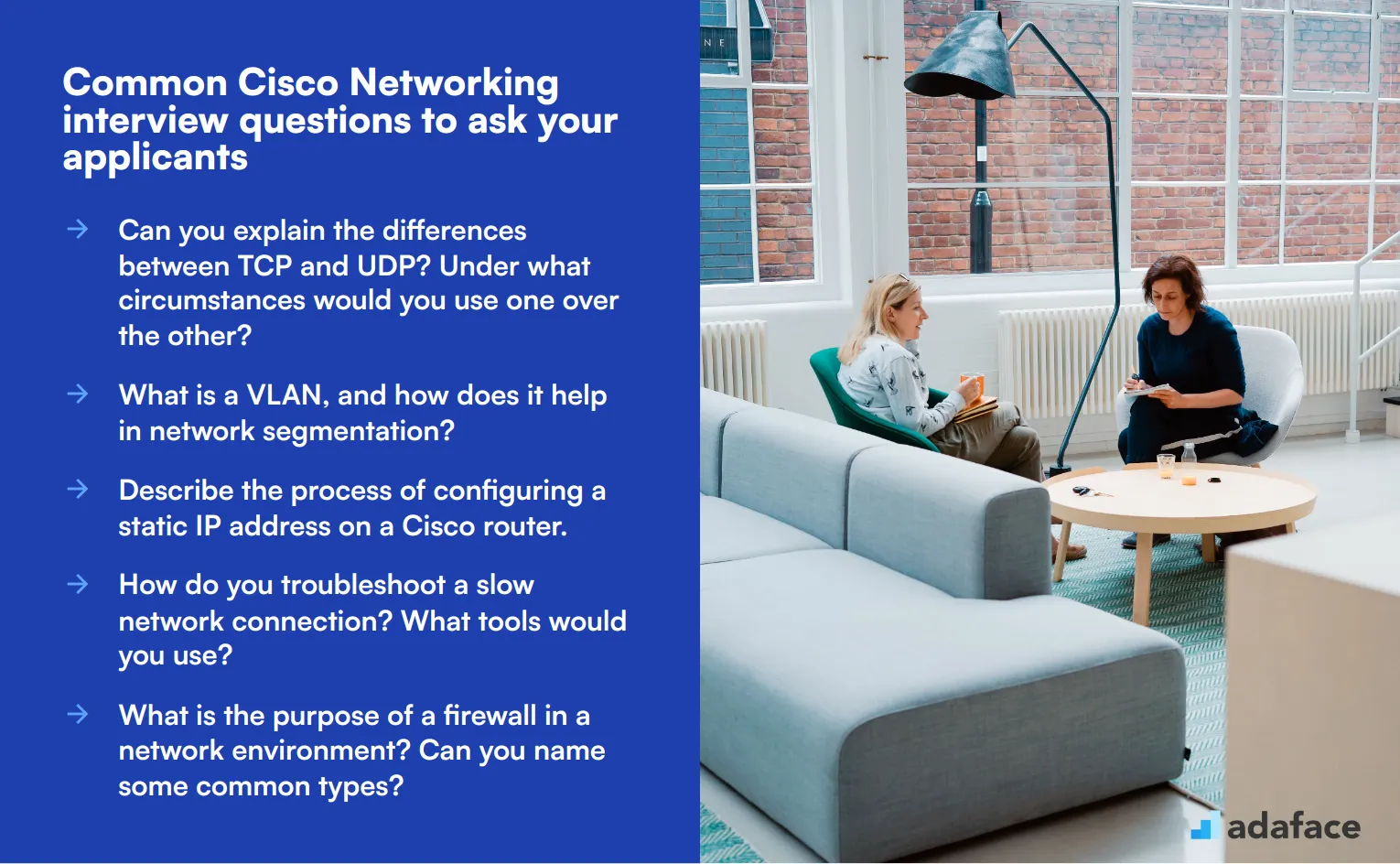
To ensure your candidates possess the essential knowledge and skills required for networking roles, consider using this list of common Cisco Networking interview questions. These queries will help you gauge their technical expertise and problem-solving abilities effectively, making your hiring process smoother. If you're looking for a detailed job description, check out this network engineer job description.
- Can you explain the differences between TCP and UDP? Under what circumstances would you use one over the other?
- What is a VLAN, and how does it help in network segmentation?
- Describe the process of configuring a static IP address on a Cisco router.
- How do you troubleshoot a slow network connection? What tools would you use?
- What is the purpose of a firewall in a network environment? Can you name some common types?
- Explain what NAT is and how it works in a networking context.
- What are the key differences between OSPF and EIGRP routing protocols?
- How would you secure a wireless network? What protocols and methods would you implement?
- Can you describe the function of Spanning Tree Protocol (STP) in a switched network?
- What steps would you take to recover from a network outage or failure?
9 Cisco Networking interview questions and answers to evaluate junior network engineers
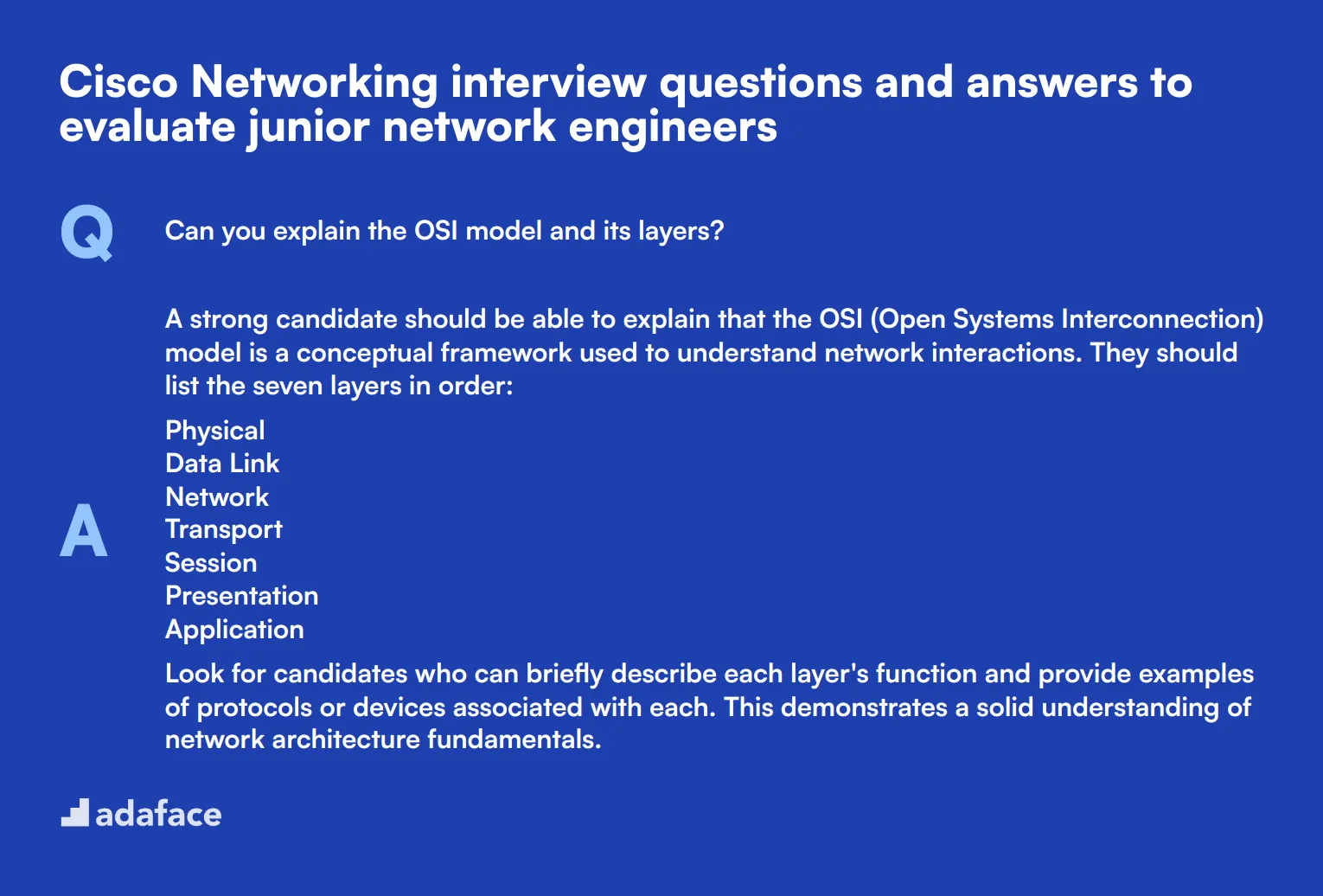
When evaluating junior network engineers, it's crucial to assess their foundational knowledge and problem-solving skills. These nine Cisco Networking interview questions will help you gauge candidates' understanding of essential concepts and their ability to apply them in real-world scenarios. Use this list to identify promising talent and ensure they have the baseline skills needed for the role.
1. Can you explain the OSI model and its layers?
A strong candidate should be able to explain that the OSI (Open Systems Interconnection) model is a conceptual framework used to understand network interactions. They should list the seven layers in order:
- Physical
- Data Link
- Network
- Transport
- Session
- Presentation
- Application
Look for candidates who can briefly describe each layer's function and provide examples of protocols or devices associated with each. This demonstrates a solid understanding of network architecture fundamentals.
2. How would you configure a DHCP server on a Cisco router?
A competent junior network engineer should outline the basic steps to configure DHCP on a Cisco router:
- Enter global configuration mode
- Create a DHCP pool
- Specify the network address and subnet mask
- Configure the default gateway
- Specify DNS servers (optional)
- Configure lease time (optional)
- Enable DHCP on the interface
Pay attention to candidates who mention the importance of excluding static IP addresses from the DHCP pool and can explain why this is necessary. This shows a deeper understanding of network management practices.
3. What is the difference between a router and a switch?
Candidates should explain that routers operate at Layer 3 (Network) of the OSI model, while switches typically operate at Layer 2 (Data Link). They should mention that:
- Routers use IP addresses to make forwarding decisions and connect different networks
- Switches use MAC addresses to forward frames within the same network
Look for answers that highlight the router's ability to perform Network Address Translation (NAT) and act as a firewall. This demonstrates a broader understanding of network security and address management.
4. Explain the concept of subnetting and why it's important.
A solid answer should explain that subnetting is the process of dividing a larger network into smaller, more manageable subnetworks. Candidates should mention benefits such as:
- Improved network performance by reducing broadcast traffic
- Enhanced security through network segmentation
- More efficient use of IP addresses
- Easier network management and troubleshooting
Pay attention to candidates who can provide a simple example of subnetting or explain CIDR notation. This indicates a practical understanding of IP addressing and network design principles.
5. What is a VLAN trunk and when would you use it?
A good response should explain that a VLAN trunk is a point-to-point link between two network devices that carries traffic for multiple VLANs. Candidates should mention that trunks are typically used:
- Between switches to extend VLANs across multiple devices
- Between a switch and a router for inter-VLAN routing
- In server environments with NIC teaming or virtual switches
Look for answers that mention the 802.1Q protocol and native VLANs. This shows a deeper understanding of VLAN implementation and potential security considerations.
6. How would you troubleshoot a connectivity issue between two devices on different VLANs?
A strong candidate should outline a systematic approach to troubleshooting, such as:
- Verify physical connections
- Check VLAN configurations on both devices and intermediate switches
- Ensure inter-VLAN routing is configured correctly (router or Layer 3 switch)
- Use ping and traceroute to identify where the communication breaks
- Check access control lists (ACLs) that might be blocking traffic
- Verify IP addressing and subnet masks are correct
Pay attention to candidates who mention using tools like 'show' commands in Cisco IOS to gather information. This demonstrates practical troubleshooting skills and familiarity with Cisco equipment.
7. What is the purpose of the Spanning Tree Protocol (STP), and how does it work?
Candidates should explain that STP prevents loops in switched networks by creating a loop-free logical topology. They should mention that STP:
- Elects a root bridge
- Determines the best path to the root bridge for each switch
- Blocks redundant links to prevent loops
- Recalculates paths if the network topology changes
Look for answers that mention different STP versions (like Rapid STP or Multiple STP) and their advantages. This shows awareness of protocol evolution and optimization techniques.
8. Explain the difference between access and trunk ports on a switch.
A good answer should clearly differentiate between access and trunk ports:
- Access ports: Belong to a single VLAN and typically connect to end devices like computers or IP phones
- Trunk ports: Carry traffic for multiple VLANs and usually connect to other switches or routers
Pay attention to candidates who mention that access ports tag incoming frames with the port's VLAN ID, while trunk ports use 802.1Q tagging to identify VLAN membership for frames. This demonstrates a deeper understanding of VLAN operation.
9. What is a routing protocol, and can you name a few examples?
Candidates should explain that routing protocols are used by routers to dynamically share information about network destinations and determine the best path for forwarding packets. They should be able to name and briefly describe common routing protocols such as:
- OSPF (Open Shortest Path First)
- EIGRP (Enhanced Interior Gateway Routing Protocol)
- BGP (Border Gateway Protocol)
- RIP (Routing Information Protocol)
Look for answers that categorize protocols into interior (IGP) and exterior (EGP) gateway protocols, or distance vector and link-state protocols. This shows a broader understanding of routing concepts and protocol characteristics.
15 intermediate Cisco Networking interview questions and answers to ask mid-tier network engineers
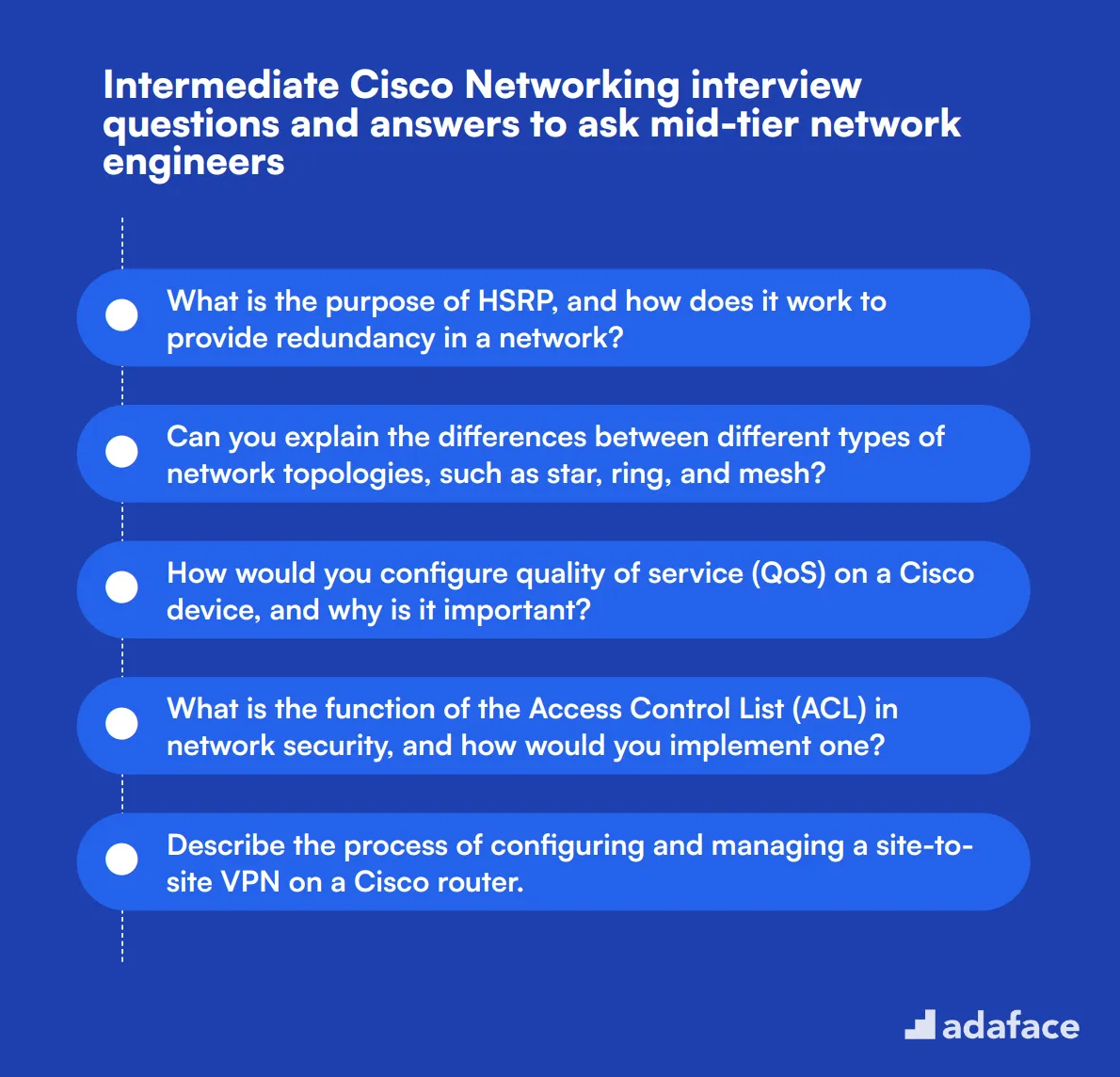
To gauge if candidates possess the necessary expertise in Cisco networking, utilize this list of intermediate interview questions. These queries will help you assess their technical skills and problem-solving abilities, essential for roles like network engineer.
- What is the purpose of HSRP, and how does it work to provide redundancy in a network?
- Can you explain the differences between different types of network topologies, such as star, ring, and mesh?
- How would you configure quality of service (QoS) on a Cisco device, and why is it important?
- What is the function of the Access Control List (ACL) in network security, and how would you implement one?
- Describe the process of configuring and managing a site-to-site VPN on a Cisco router.
- How do you analyze and interpret the output of the 'show interface' command?
- What steps would you take to set up a basic BGP configuration?
- Can you explain the role of DHCP relay and when you would use it?
- What are some common causes of packet loss in a network, and how would you troubleshoot it?
- How would you implement port security on a Cisco switch, and what are its benefits?
- What is the function of Syslog in network management, and how would you configure it on a Cisco device?
- Describe the difference between RADIUS and TACACS+ in network authentication.
- What is the purpose of a load balancer, and how would you configure one in a Cisco environment?
- How can you ensure high availability in a network design?
- Explain the concept of link aggregation and how it benefits network performance.
8 advanced Cisco Networking interview questions and answers to evaluate senior network engineers
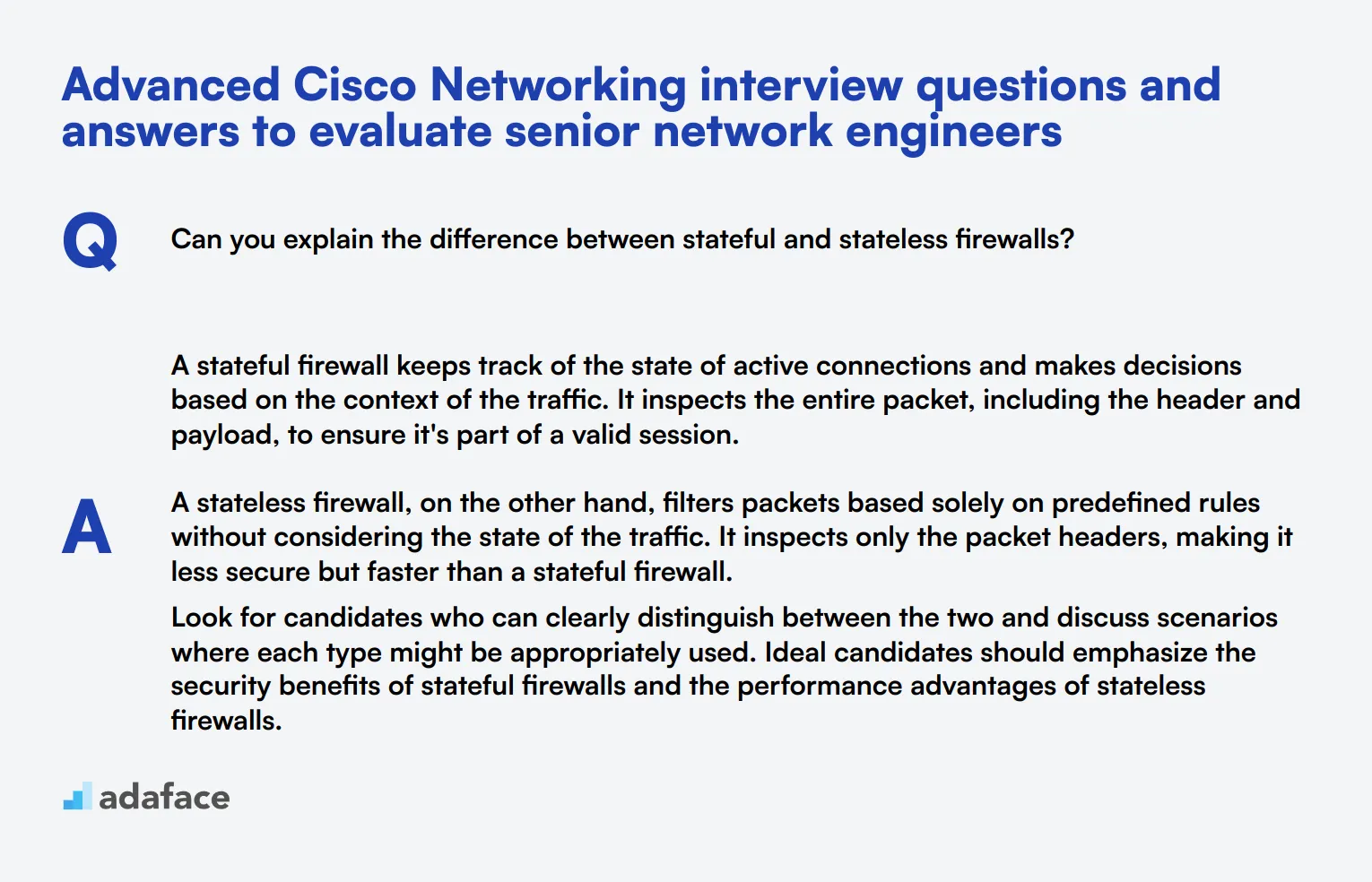
Finding top-notch senior network engineers can be challenging. To help you evaluate if your candidates have the advanced Cisco Networking skills necessary for the role, we’ve compiled a list of key interview questions. Use these questions to get a deep understanding of their expertise and problem-solving abilities.
1. Can you explain the difference between stateful and stateless firewalls?
A stateful firewall keeps track of the state of active connections and makes decisions based on the context of the traffic. It inspects the entire packet, including the header and payload, to ensure it's part of a valid session.
A stateless firewall, on the other hand, filters packets based solely on predefined rules without considering the state of the traffic. It inspects only the packet headers, making it less secure but faster than a stateful firewall.
Look for candidates who can clearly distinguish between the two and discuss scenarios where each type might be appropriately used. Ideal candidates should emphasize the security benefits of stateful firewalls and the performance advantages of stateless firewalls.
2. How would you approach designing a scalable network infrastructure for a growing company?
Designing a scalable network infrastructure involves planning for future growth and ensuring the network can handle increased traffic and additional devices. Key considerations include: choosing scalable hardware, implementing robust routing protocols, and ensuring redundancy and failover capabilities.
Candidates should also mention the importance of modular design, which allows for easy expansion, and the implementation of VLANs to segment network traffic efficiently.
Look for responses that demonstrate a strategic approach to scalability and an understanding of both current and future network requirements. Ideal candidates should also highlight the importance of regular network assessments and updates.
3. What steps would you take to perform a network security audit?
Performing a network security audit involves several steps: firstly, defining the scope and objectives of the audit. This includes identifying all network assets and understanding the current security policies in place.
Next, the candidate should mention conducting a vulnerability assessment to identify potential security weaknesses, followed by penetration testing to simulate attacks and assess the network's defenses.
Finally, the audit findings should be documented, and recommendations for improving security should be made. Look for candidates who emphasize a thorough, methodical approach and the importance of regularly updating security measures.
4. How do you manage and monitor network performance in a large enterprise setting?
Managing and monitoring network performance in a large enterprise requires using network management tools to collect performance data and monitor key metrics such as bandwidth utilization, latency, and packet loss.
Candidates should mention the use of SNMP (Simple Network Management Protocol) for real-time monitoring and the importance of setting up alerts for unusual activities. Additionally, they should discuss analyzing historical data to identify trends and potential issues.
Look for responses that demonstrate familiarity with various network monitoring tools and the ability to interpret performance data to proactively address performance issues.
5. What is the role of MPLS in modern networking?
MPLS (Multiprotocol Label Switching) is a technique used to speed up and shape traffic flows across enterprise and service provider networks. It directs data from one node to the next based on short path labels rather than long network addresses.
Candidates should explain how MPLS improves the efficiency and speed of data transfer, supports Quality of Service (QoS) for prioritizing traffic, and enhances the flexibility of network routing.
An ideal candidate will articulate real-world advantages of MPLS, such as its ability to manage bandwidth and its role in connecting multiple branch offices efficiently.
6. Can you describe a time when you had to troubleshoot a complex network issue? What steps did you take?
Candidates should describe a specific incident, outlining the nature of the network issue and its impact. They should detail the systematic approach they took to troubleshoot, such as identifying and isolating the problem, using diagnostic tools, and consulting logs.
They should also discuss how they communicated with team members and escalated the issue if necessary. Finally, they should mention the solution and any preventive measures implemented to avoid similar issues in the future.
Look for responses that demonstrate strong problem-solving skills, effective communication, and a proactive approach to network management.
7. How do you ensure compliance with network security standards and regulations?
Ensuring compliance with network security standards involves staying updated with relevant regulations, such as GDPR, HIPAA, or PCI-DSS. Candidates should discuss conducting regular audits and assessments to identify any compliance gaps.
They should also explain the importance of implementing and maintaining security policies and procedures, providing regular training to staff, and documenting compliance activities.
Ideal candidates will emphasize a thorough understanding of compliance requirements and a proactive approach to maintaining adherence to these standards.
8. How do software-defined networking (SDN) and traditional networking differ?
Software-defined networking (SDN) separates the control plane from the data plane, allowing network management to be more flexible and programmable. SDN uses centralized controllers to manage the network traffic dynamically.
Traditional networking relies on hardware-based devices such as routers and switches, where the control and data planes are integrated. This approach is less flexible and harder to manage at scale.
Look for candidates who can clearly explain the benefits of SDN, such as improved network agility and simplified management, and discuss scenarios where SDN might be more advantageous than traditional networking.
12 Cisco Networking interview questions about protocols and configurations
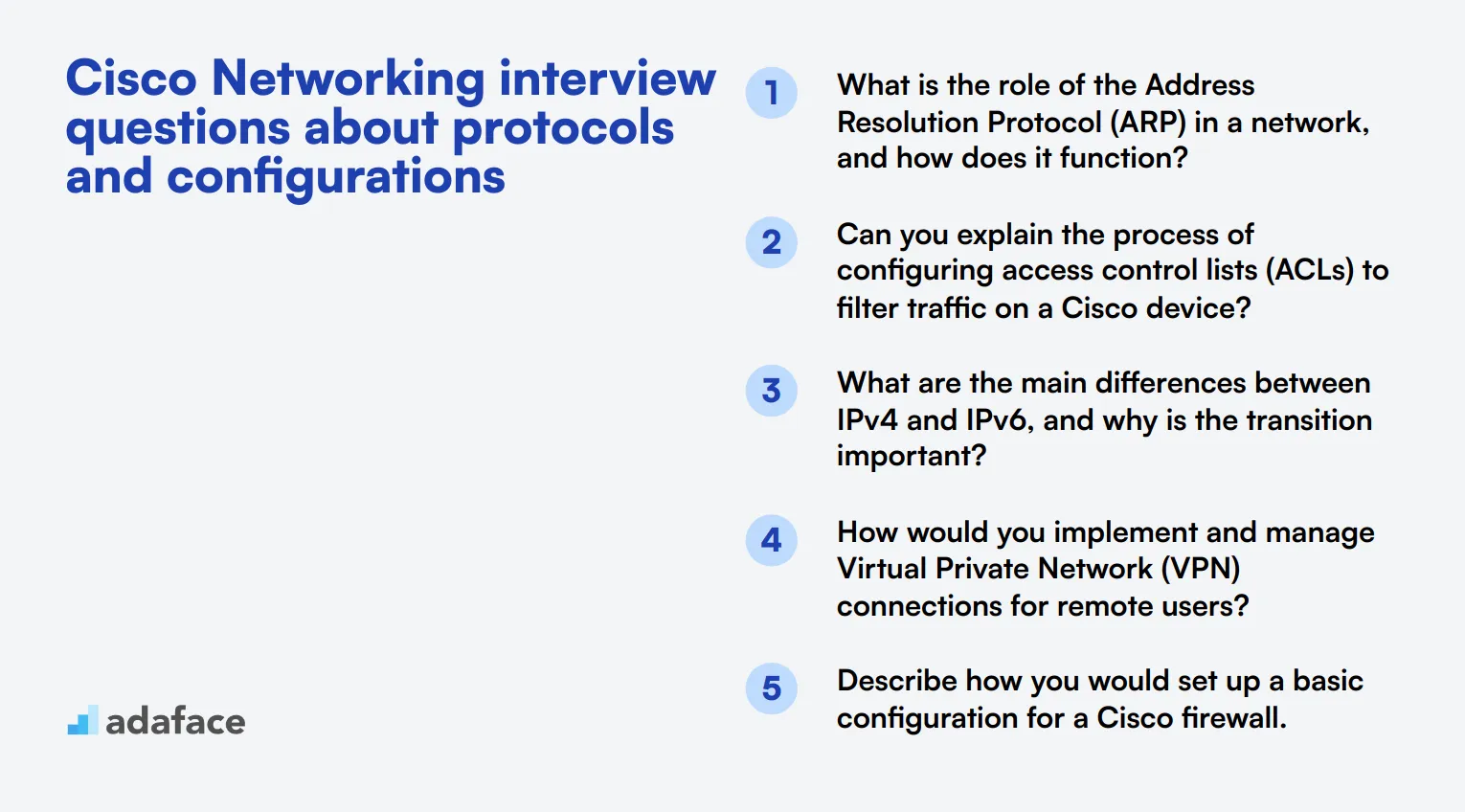
To ensure your candidates have a solid understanding of Cisco networking protocols and configurations, use these targeted questions during interviews. They will help you gauge a candidate's technical expertise and practical experience, which is crucial for roles like a network engineer.
- What is the role of the Address Resolution Protocol (ARP) in a network, and how does it function?
- Can you explain the process of configuring access control lists (ACLs) to filter traffic on a Cisco device?
- What are the main differences between IPv4 and IPv6, and why is the transition important?
- How would you implement and manage Virtual Private Network (VPN) connections for remote users?
- Describe how you would set up a basic configuration for a Cisco firewall.
- What is the purpose of the Link Layer Discovery Protocol (LLDP), and how does it operate?
- How do you configure port mirroring on a Cisco switch for network analysis?
- What are common techniques to prevent DHCP spoofing in a network environment?
- Can you explain the difference between static and dynamic routing, and when to use each?
- How would you troubleshoot a routing loop in a network?
- What is the function of the Network Time Protocol (NTP), and how would you configure it on a Cisco device?
- Can you describe how to use SNMP for network monitoring and management?
10 Cisco Networking interview questions about troubleshooting and diagnostics
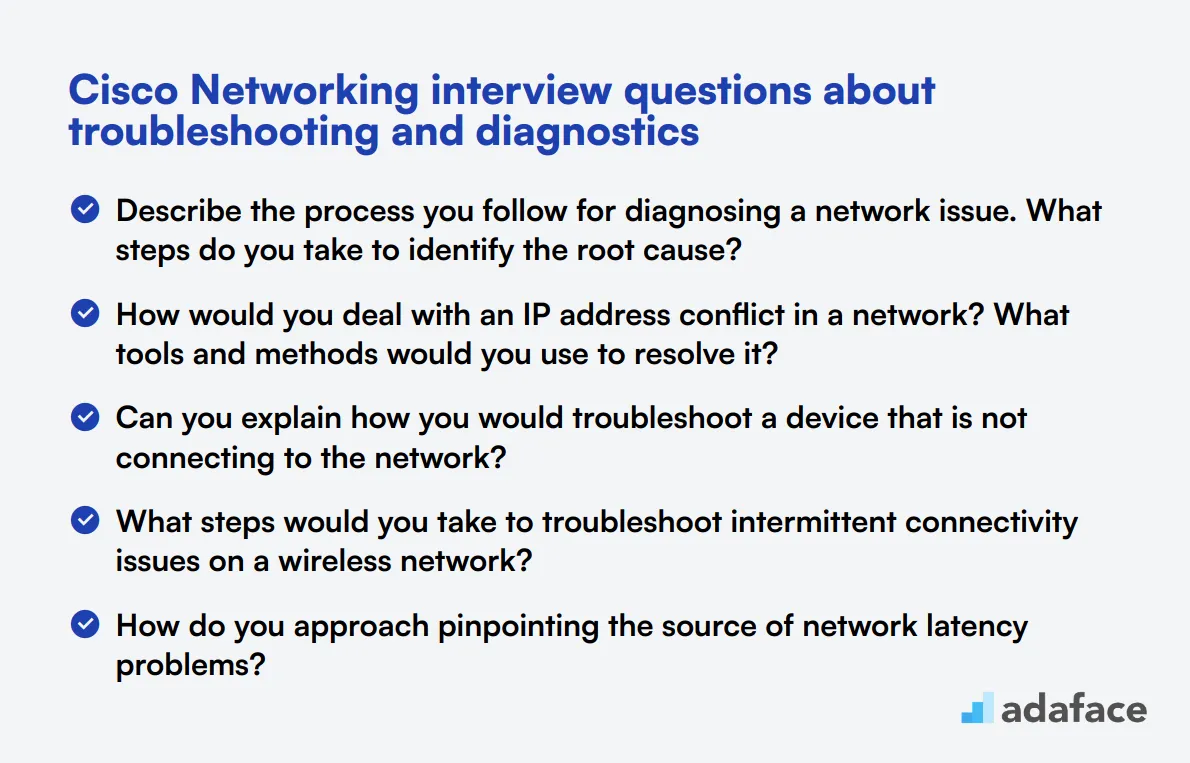
To assess the troubleshooting and diagnostic skills of your Cisco networking candidates, consider incorporating some of these targeted questions into your interview process. These questions are designed to help you evaluate an applicant's problem-solving abilities and technical expertise when faced with real-world networking issues. For more insights on crafting a comprehensive interview, you can refer to network technician job description.
- Describe the process you follow for diagnosing a network issue. What steps do you take to identify the root cause?
- How would you deal with an IP address conflict in a network? What tools and methods would you use to resolve it?
- Can you explain how you would troubleshoot a device that is not connecting to the network?
- What steps would you take to troubleshoot intermittent connectivity issues on a wireless network?
- How do you approach pinpointing the source of network latency problems?
- What methods would you use to diagnose a routing issue between two different networks?
- How do you determine if a network problem is hardware or software related?
- Describe a time when you had to troubleshoot a complex VLAN issue. What was your approach and the outcome?
- What is the role of logging in network troubleshooting, and how do you use logs effectively?
- How would you handle a situation where multiple users are experiencing slow internet speeds?
14 situational Cisco Networking interview questions for hiring top network engineers
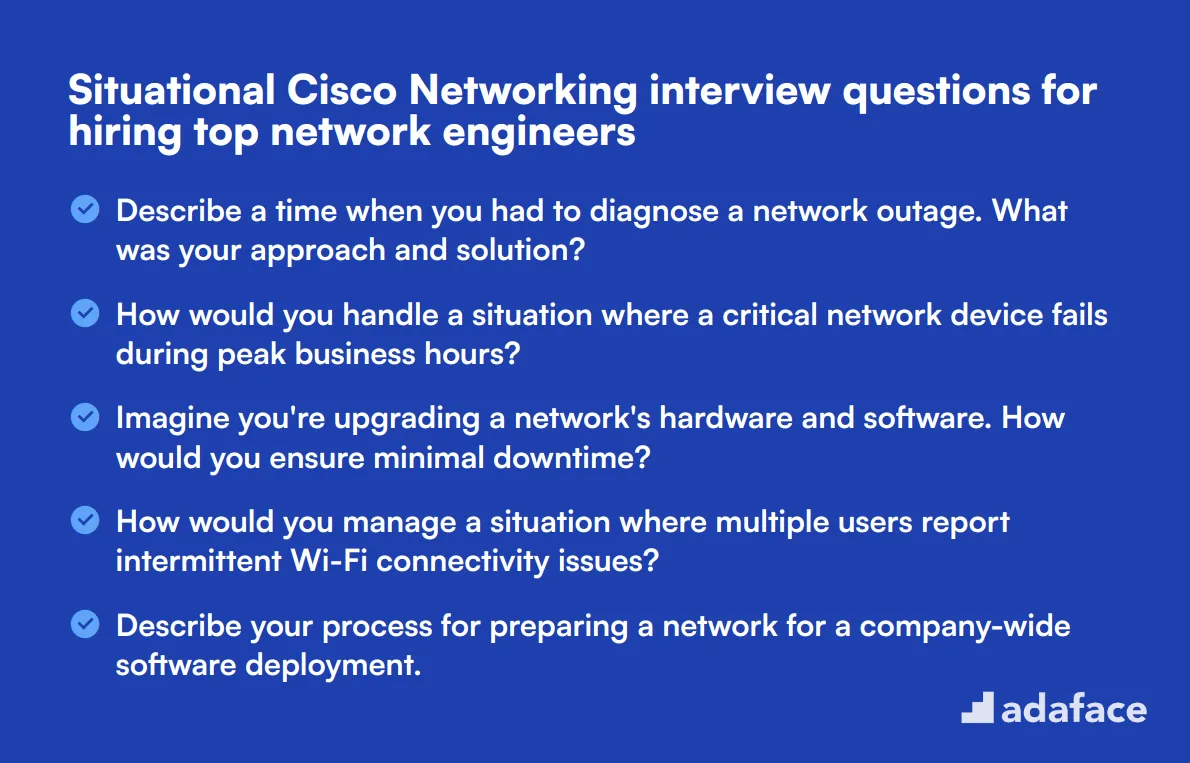
To hire top network engineers, it's essential to ask the right situational Cisco Networking interview questions. These questions help you gauge a candidate's practical skills and problem-solving abilities in real-world scenarios.
- Describe a time when you had to diagnose a network outage. What was your approach and solution?
- How would you handle a situation where a critical network device fails during peak business hours?
- Imagine you're upgrading a network's hardware and software. How would you ensure minimal downtime?
- How would you manage a situation where multiple users report intermittent Wi-Fi connectivity issues?
- Describe your process for preparing a network for a company-wide software deployment.
- How would you approach troubleshooting a situation where a particular application is running slowly across the network?
- Explain how you would deal with a scenario where a network segment is experiencing significant packet loss.
- What steps would you take if you discovered unauthorized devices connected to your network?
- Describe how you would handle a situation where a user’s device cannot obtain an IP address from the DHCP server.
- How would you prioritize and address multiple network issues reported at the same time?
- Explain how you would approach designing a network for a new branch office.
- How would you conduct a network security audit to ensure compliance with regulatory standards?
- Describe a scenario where you had to integrate a new network segment into an existing infrastructure. What challenges did you face, and how did you overcome them?
- How would you handle an incident where sensitive data is being exfiltrated from the network?
Which Cisco Networking skills should you evaluate during the interview phase?
While it's impossible to assess every aspect of a candidate's Cisco Networking expertise in a single interview, focusing on core skills is crucial. These key areas provide a solid foundation for evaluating a candidate's proficiency and potential fit for the role.
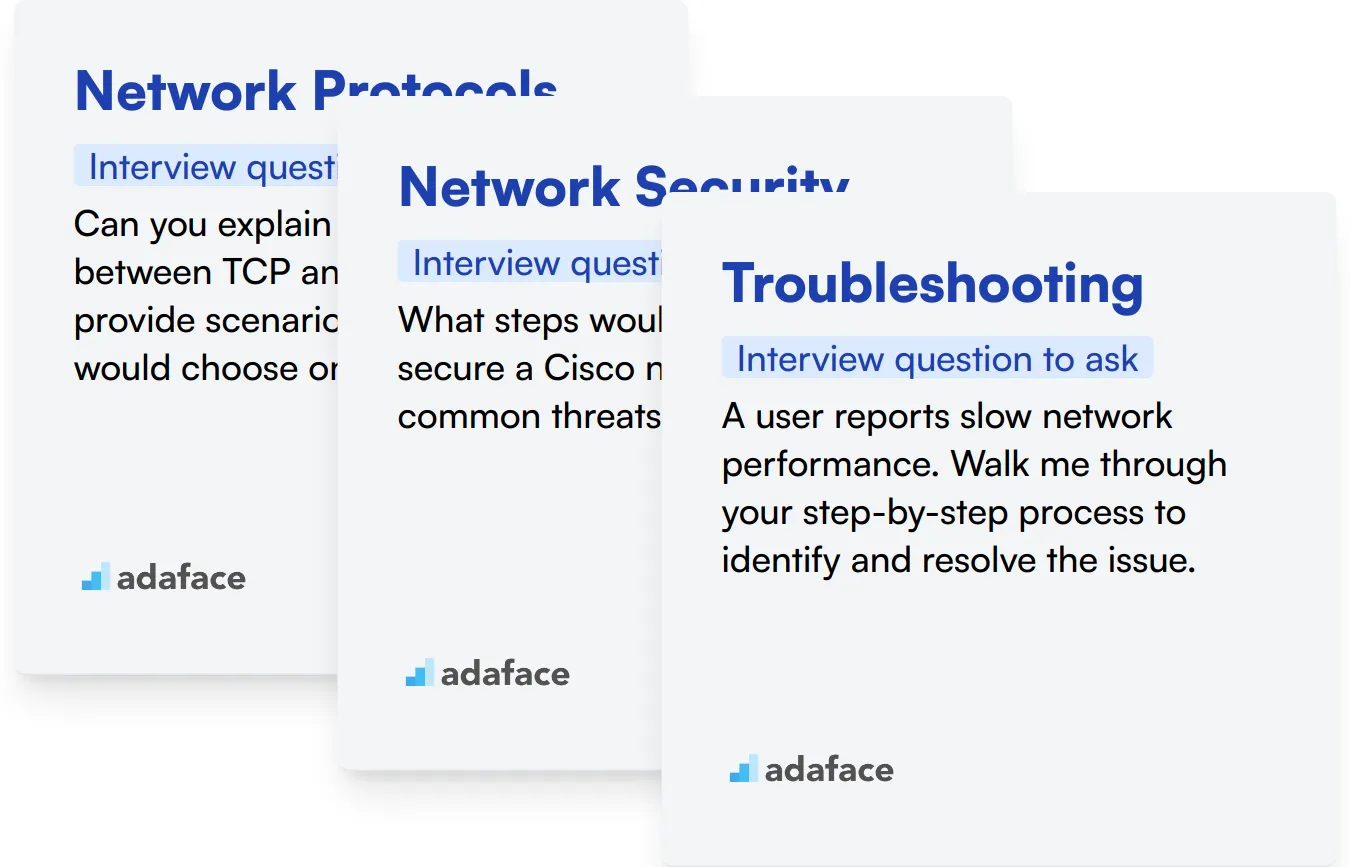
Network Protocols
Understanding network protocols is fundamental for Cisco Networking professionals. It forms the basis for effective network design, troubleshooting, and optimization.
To evaluate this skill, consider using an assessment test with relevant multiple-choice questions. These can help filter candidates based on their protocol knowledge.
During the interview, you can ask targeted questions to gauge the candidate's understanding of network protocols. Here's an example:
Can you explain the difference between TCP and UDP, and provide scenarios where you would choose one over the other?
Look for answers that demonstrate a clear understanding of both protocols' characteristics, including reliability, speed, and use cases. Strong candidates will provide specific examples of when each protocol is preferable.
Network Security
Network security is critical in today's digital landscape. Cisco Networking professionals must be well-versed in implementing and maintaining robust security measures.
Consider using a comprehensive assessment test to evaluate candidates' knowledge of network security concepts and best practices.
To further assess this skill during the interview, you can ask a question like:
What steps would you take to secure a Cisco network against common threats?
Listen for responses that include multiple layers of security, such as firewalls, VPNs, access control lists, and intrusion detection systems. Candidates should also mention the importance of regular updates and monitoring.
Troubleshooting
Effective troubleshooting is essential for maintaining network performance and resolving issues quickly. It requires a combination of technical knowledge and analytical thinking.
Use a targeted assessment test to evaluate a candidate's troubleshooting skills through scenario-based questions.
During the interview, present a hypothetical network issue to assess the candidate's troubleshooting approach:
A user reports slow network performance. Walk me through your step-by-step process to identify and resolve the issue.
Look for a structured approach that includes gathering information, isolating the problem, considering potential causes, and methodically testing solutions. Strong candidates will also mention documenting the process and implementing preventive measures.
Streamline Your Hiring Process with Cisco Networking Skills Tests and Targeted Interview Questions
When aiming to hire professionals with Cisco Networking skills, it's important to accurately verify their expertise. Ensuring candidates truly possess the skills they claim often sets the foundation for successful hiring.
The most straightforward method to assess these abilities is through specialized skill tests. Consider utilizing our Cisco Routing & Switching Online Test or the Cisco Security Online Test to evaluate the technical proficiency of your candidates.
After candidates pass the skill tests, you can efficiently shortlist the top applicants. This filtered group can then be invited for in-depth interviews to further assess their fit for your organization.
To move forward and start integrating skill tests into your hiring process, you can sign up here: Adaface Signup. This will allow you to access a variety of tests and further streamline your recruitment efforts.
CISCO Routing Switching Test
Download Cisco Networking interview questions template in multiple formats
Cisco Networking Interview Questions FAQs
The questions cover junior, mid-tier, and senior-level Cisco Network Engineers, providing a comprehensive range for different experience levels.
Yes, the post includes a section dedicated to troubleshooting and diagnostics questions for Cisco Networking.
You can select questions based on the candidate's experience level and the specific role requirements, using them during interviews to assess technical knowledge and problem-solving skills.
Yes, the post features a section with situational Cisco Networking interview questions to evaluate candidates' practical skills and decision-making abilities.
It's advisable to review and update your questions periodically, especially when new technologies or certifications emerge in the Cisco Networking field.

40 min skill tests.
No trick questions.
Accurate shortlisting.
We make it easy for you to find the best candidates in your pipeline with a 40 min skills test.
Try for freeRelated posts
Free resources




